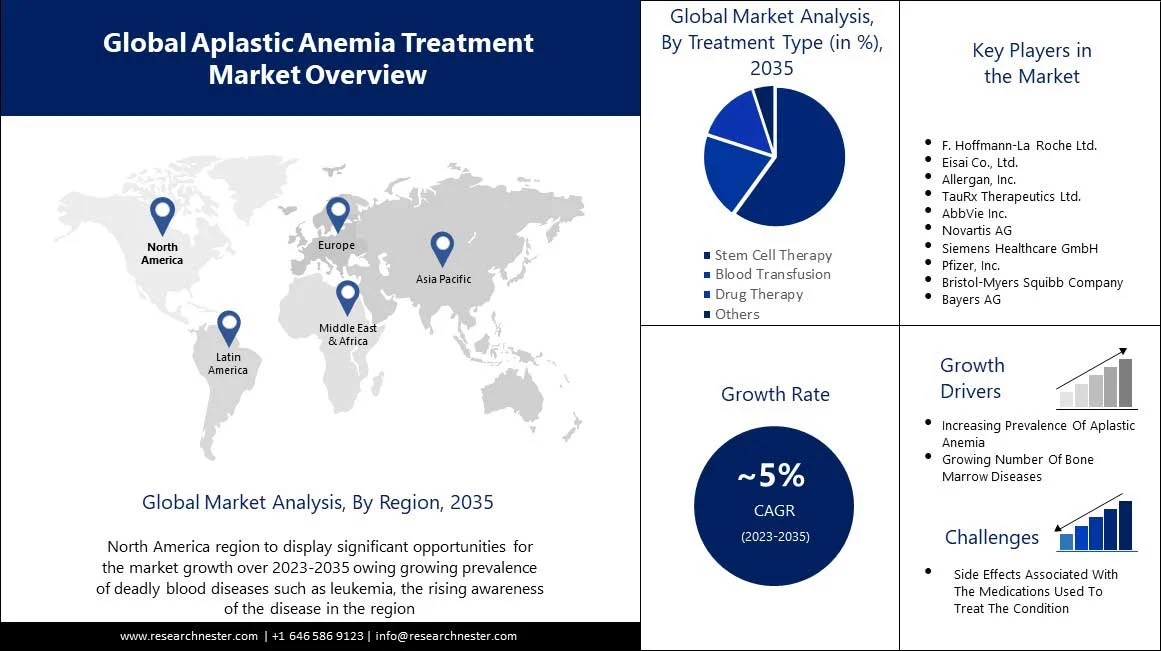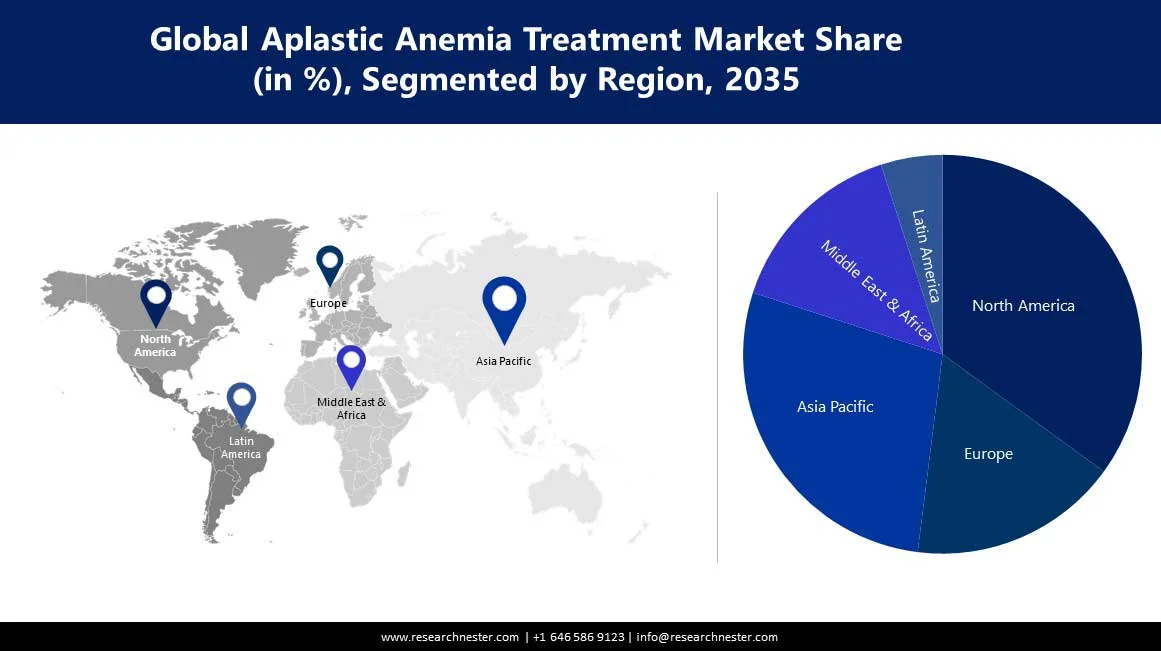
Aplastic Anemia Treatment Market size is expected to reach USD 11312 million by the end of 2035, growing at a CAGR of 5% during the forecast period, i.e., 2023-2035. In the year 2022, the industry size of aplastic anemia treatment was over USD 6280 million. This growth can be attributed to increasing prevalence of aplastic anemia, increasing awareness about aplastic anemia and its treatment as well as increasing investments in research and development of aplastic anemia treatment therapies. There are approximately equal numbers of males and females suffering from aplastic anemia. The greatest incidence of aplastic anemia occurs in childhood, although it affects people of all ages. Between the ages of 20 and 25, there is an additional peak. Around 700 to 800 Americans are diagnosed with aplastic anemia each year. Early diagnosis of aplastic anemia is important as it allows doctors to identify the underlying cause of the disease, which can help them determine the best treatment plan for the patient. Additionally, early diagnosis gives patients more time to make lifestyle changes that can help reduce the risk of complications, such as avoiding activities that can weaken the immune system.
Early treatment aplastic anemia is necessary in order to prevent the bone marrow from becoming completely non-functional. Without treatment, the body will not be able to produce the necessary red and white blood cells, leading to anemia, infections, and other complications. Aplastic anemia treatment depends on the severity of the condition, but may include medications to increase white blood cell production, blood transfusions, immunosuppressant medications, and stem cell transplants.
In some cases, a bone marrow transplant may be necessary. Medications may be used to stimulate the production of new blood cells, or the patient may receive blood transfusions or immunosuppressant medications to help regulate their immune system. In more severe cases, a bone marrow transplant or stem cell transplant may be necessary to replace the affected bone marrow with healthy blood-forming cells.
In addition to these, factors that are believed to fuel the market growth of aplastic anemia treatment include the rising geriatric population, continuous technological advancements in stem cell therapy, and increasing awareness among patients and healthcare providers. Moreover, the development of novel treatments, such as gene therapy and stem cell therapy along with rise in number of clinical trials is further contributing to the growth of the market. Clinical trials provide a platform for the evaluation and approval of new drugs, ultimately resulting in an increase in the availability of drugs. Consequently, new treatments for aplastic anemia have been adopted, contributing to an increase in market revenue.

Growth Drivers
Challenges
|
Base Year |
2022 |
|
Forecast Year |
2023-2035 |
|
CAGR |
~5% |
|
Base Year Market Size (2022) |
~USD 6,280 Million |
|
Forecast Year Market Size (2035) |
~USD 11,312 Million |
|
Regional Scope |
|
Treatment Type (Stem Cell Therapy, Blood Transfusion, Drug Therapy)
The global aplastic anemia treatment market is segmented and analyzed for demand and supply by treatment type into stem cell therapy, blood transfusion, drug therapy, and others. Out of these segments, the stem cell therapy segment is estimated to gain the largest market share by the end of year 2035. The growth of the segment can be attributed to the increasing focus of leading players in the market to invest in research and development for the development of new stem cell therapies for the treatment of aplastic anemia, as well as the rising number of clinical trials for the development of new medicines. Moreover, stem cell therapy has been demonstrated to be an effective treatment option for aplastic anemia, as it helps to restore the patient’s normal blood cell production and reduce the severity of the symptoms. Researchers have found that stem cell transplantation can treat non-malignant conditions such as aplastic anemia with a 75 percent to 80% success rate. Stem cell therapy is currently successful in India with a success rate of approximately 67%-88%. Additionally, the growing awareness among people regarding the availability of novel treatments for aplastic anemia is also set to drive the growth of the stem cell therapy segment.
Disease Type (Acquired Aplastic Anemia, Inherited Aplastic Anemia)
The global aplastic anemia treatment market is also segmented and analyzed for demand and supply by disease type into acquired aplastic anemia and inherited aplastic anemia. Among these segments, inherited aplastic anemia is expected to gain the highest market share by 2035. The growth of the segment can be attributed to the increasing prevalence of genetic disorders, and the availability of novel treatments. These genetic mutations affect the body's ability to produce new blood cells, resulting in aplastic anemia. It can be inherited from either parent, or both, and can be passed down from generation to generation. A congenital or inherited cause has been noted in at least 26% of childhood cases, and perhaps as high as 12% of adult cases. Additionally, with the rising awareness about this disorder, more people are becoming aware of the signs and symptoms, which may enable early detection, and thus, more effective treatments.
Our in-depth analysis of the global market includes the following segments:
|
By Treatment Type |
|
|
By Disease Type |
|
|
By Route of Administration |
|
|
By End User |
|
North American Market Forecast
The North American aplastic anemia treatment market, amongst the market in all the other regions, is projected to hold the largest market share by the end of 2035. The growth of the market is attributed to the availability of advanced treatment options for aplastic anemia, such as bone marrow transplantation, immunosuppressive therapy, and blood transfusions. In addition, the growing prevalence of deadly blood diseases such as leukemia, the rising awareness of the disease, and the increasing government funding for treatment are expected to drive regional market growth. The rising prevalence of blood disorders such as leukemia is primarily attributed to lifestyle changes, increasing exposure to environmental toxins, and genetic mutations. In 2021, the US experienced 186,400 new cases of leukemia, lymphoma, and myeloma. Based on the Leukemia & Lymphoma Society, approximately one person is diagnosed with leukemia, lymphoma, or myeloma every three minutes. Blood cancer was expected to account for about 10% of cancer diagnoses in Canada in 2019. Aplastic anemia treatment helps to treat leukemia by targeting the bone marrow, which is where leukemia originates. The treatment reduces the amount of abnormal white blood cells in the bone marrow, which helps to reduce the spread of cancer cells.
APAC Market Statistics
The Asia Pacific aplastic anemia treatment market, amongst the market in all the other regions, is projected to hold the second largest share during the forecast period. The growth of the market can be attributed to the increasing prevalence of aplastic anemia and the introduction of novel therapies such as hematopoietic stem cell transplantation (HSCT) and immunosuppressive therapy (IST). Over the period from 2008 to 2019, 58,914 hematopoietic stem cell transplantations were reported by the Chinese Blood and Marrow Transplant Registry Group (CBMTRG). It is estimated that 12,323 HSCTs have been performed in 2019 from 149 transplant teams, of which 78% (9577) are allogeneic. Since the technology is more advanced and widely available in the region, stem cell donors are easier to find and HSCTs are more affordable. As a result, more patients are able to access HSCTs and HSCTs are being performed in Asia Pacific, resulting in a rise in the need for treatment of aplastic anemia. Additionally, the rising number of clinical trials and the growing focus on research and development of novel treatments are expected to drive the growth of the market in the Asia Pacific region.
Europe Market Forecast
Further, the aplastic anemia treatment market in the Europe, amongst the market in all the other regions, is projected to hold a majority of the share by the end of 2035. The growth of the market can be attributed the presence of advanced healthcare infrastructure and the availability of efficient and advanced treatment options such as stem-cell transplantation, chemotherapy and other treatments in the European region. Additionally, the rising awareness about the disease and the availability of government initiatives and healthcare subsidies to improve the access to treatments for the disease are expected to drive the growth of the market in the region. The increasing number of clinical trials that are being conducted in the region to develop new treatments and the growing number of collaborations between the government and the private entities to improve the access to better treatments are also expected to drive the growth of the market.



Sandoz announced the acquisition of GSK's cephalosporin antibiotic business to expand its collection of antimicrobials. This acquisition allows Sandoz to increase its portfolio of antibiotics, which is beneficial for both Sandoz and the patients they serve. The acquisition also gives Sandoz access to GSK's patented technology, which will help them stay competitive in the industry.
In Europe, the European Commission approved the consolidation of Mylan and Upjohn between Pfizer and Mylan. Combining Mylan's generics market presence with Pfizer's branded market presence will enable the companies to create a new global healthcare leader.
Author Credits: Radhika Gupta, Shivam Bhutani
Copyright © 2024 Research Nester. All Rights Reserved

FREE Sample Copy includes market overview, growth trends, statistical charts & tables, forecast estimates, and much more.
Have questions before ordering this report?